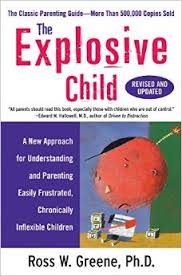Review of The Explosive Child, by Ross Greene

Ross Greene’s book, The Explosive Child, is one of my three all time favorite parenting books (click this link to see my three must read parenting books). In this book, Dr. Greene argues that conventional parenting approaches that are based on limits and consequences do not work well with explosive children. This perspective contradicts the position of many experts who say that explosive kids need firmer limits and clearer consequences. Greene points out that consequence based approaches address the child’s motivation to comply. In other words, a child is more motivated to comply with parental requests because of his/her desire to avoid bad consequences and to get good consequences. Dr. Greene suggests that explosive children want to cooperate (i.e. they are motivated to cooperate), but they are unable to cooperate because of a delay in the development of critical cognitive skills required for cooperation: flexibility and frustration tolerance. Just as it does not make sense to treat a learning disorder with rewards and punishment – rather we work to help the child develop the skills necessary to succeed – it doesn’t make sense to use rewards and punishments to address a delay in the development of the skills necessary for cooperation.
Pathways and Triggers
“Pathways” is the term that Greene uses to refer to the specific lagging skills that make it difficult for kids to comply with parental requests and which make them vulnerable to explosions. These pathways include executive functioning skills, language processing skills, emotion regulation skills, cognitive flexibility skills, and social skills.
A “trigger” is “a situation or event that routinely precipitates explosive outbursts” (Greene, p. 47). Green argues that most explosive kids are provoked by a relatively small number of highly predictable triggers. Identifying what a child’s triggers are gives parents the ability to anticipate explosions.
For example, a child might regularly respond with explosions to requests that he turn off a video game. The trigger is the request to stop playing the game and the pathway is a lack of the ability on the part of the child to shift cognitive set (an executive skill.) A child who has the skill to shift cognitive set more easily might grumble at having to shut the game off, but can do so without being overwhelmed and exploding.
Greene describes an approach to dealing with explosions that he calls Collaborative Problem Solving (CPS). He considers triggers and the explosions that they precipitate to be “problems that have yet to be solved” (p. 47). Explosions are a maladaptive attempt on the part of the child to solve the problem. CPS is an adaptive approach. CPS has three parts. In part 1, the parent uses Empathy to come to an understanding of what the child’s concern is. In part 2, Define the Problem, the parent puts his or her own concern on the table. The problem “defined” is the two conflicting concerns that are creating the power struggle. In part 3, Invitation, the parent and child brainstorm possible solutions to the conflict. The solutions need to be reasonable, doable and mutually agreeable. Collaborate Problem Solving is done in calm moments to create a plan to deal with conflicts and deal with future potential explosions before they occur.
Overview
Ross Greene’s book is well worth the read for the parent of an explosive child. His way of understanding why children explode is extremely helpful. It helps parents avoid the blame game in which they feel at fault for their child’s explosions and they develop a negative image of their child as manipulative, demanding or bad. Identifying triggers can be a particularly helpful activity. Parents of explosive children can feel as if they are sitting on a ticking time bomb 24/7. Once parents have figured out what their child’s triggers are, they can at least relax when those triggers are not present. This can provide great relief. Finally, Green’s CPS is a sound and easy to follow method for improving communication and problem solving between any set of parents and children and its value is not limited to families of explosive children.
